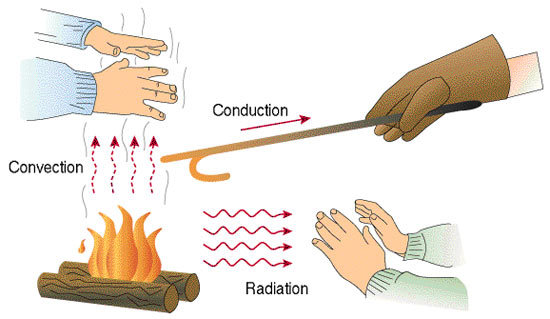Physiologic Effects of Heat
A brief video message from Christina about studying effectively
![]()
![]()
- mild heating effect: tissue temperature < 40° C (104° F)
- vigorous heating effect in tissue occurs between 40°- 45° C (104-113 ° F)
- tissue damage and thermal pain above 45° C
- heat accumulation in tissue is based on circulation, intensity and duration of heat stimulus, and tissue properties
Heat can produce a multifactorial effects in body tissues and systems:
|
Hemodynamic |
Increased circulation |
|
Neuromuscular |
Increased nerve conduction velocity Increased pain threshold Changes in muscle strength |
|
Metabolic |
Increased metabolic rate |
|
Elastic |
Increased collagen extensibility |
Five Mechanisms of Heat Exchange

https://upload.wikimedia.org/wikipedia/commons/e/e6/Heat-transmittance-means1.jpg
- Conduction - two surfaces directly touching each other (e.g. hot and cold packs)
- Convection - circulation between two mediums of different temperatures (e.g. fluidotherapy, whirlpool)
- Conversion - nonthermal energy becomes thermal (e.g. ultrasound)
- Radiation - direct transfer of energy without a medium for transfer (e.g. ultraviolet radiation)
- Evaporation - transfer of energy that causes a liquid to gas state with resultant cooling (e.g. sweating, vapocoolant sprays)
Key point: superficial thermal agents (like a hot pack) do not increase temperature below a depth of 12 cm.Once the heat source is removed, temperature changes dissipate almost immediately.
The increased circulation rates to muscles results in bringing cooler blood to the treatment area, and homeostasis with muscle temperatures is maintained. Application of heat to reduce pain from a muscle strain is based on increasing the pain-inhibiting nerves and receptors found in the skin and tendons. Decreased muscle guarding decreases pain.
Exercise (isometric, or other) combined with heat produces the greatest increase to circulation and metabolic rates in body tissues
Goals for Using Heat as an Intervention
|
Impairments and Goals |
Treatment considerations |
Functional Outcome |
|
Decrease pain
|
Position patient for comfort |
Improve functional activity or improved functional ROM |
|
Decrease spasm |
Position patient so stretch to affected muscles is reduced |
Improved mobility |
|
Increase tissue extensibility |
Position patient so stretch on affected soft tissue is on slight stretch |
Improve functional ROM (e.g., reaching, bending) |
|
Increase circulation Promote tissue healing
|
Screen for benefits in facilitating inflammatory responses (histamine and prostaglandin release) |
Improve function
|
Clinical Indicators for Heat Application
Chronic musculoskeletal conditions show ability to benefit from heat. Impairments resulting from chronic spinal pain, sprains and strains, and postural dysfunctions are examples where therapeutic heat can be an integral part of promoting functional recovery.
Conditions and impairments associated with loss of soft tissue extensibility (e.g. scar tissue, myofascial syndromes, joint disorders) can also benefit from thermal agents.

